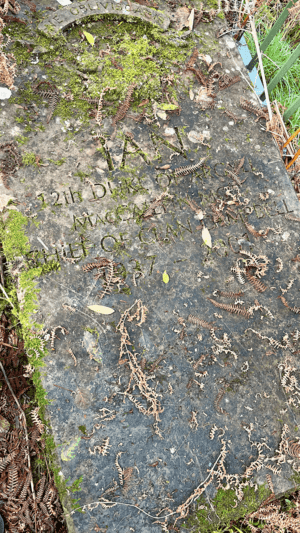Chapel of St Fyndoca facts for kids
The Chapel of St Fyndoca is a very old church building found on Inishail island. This island is located in Loch Awe, a beautiful lake in Argyll and Bute, Scotland. The chapel was once the main church for the area around Inishail. This included nearby islands and parts of the land around the loch.
The church was first mentioned in the mid-1200s. However, it stopped being used in the 1700s. Today, it is a ruin, meaning it's an old building that has fallen apart. It is surrounded by a graveyard with old carved stones from the Middle Ages. There are also newer gravestones from after the Reformation. The people in this area now go to Glenorchy Parish Church in Dalmally. The remains of the chapel and its burial ground are protected as a special historical site.
Contents
History of the Chapel
The Chapel of St Fyndoca has a long and interesting past. Records from a book called Origines Parochiales Scotiae tell us more.
Early Beginnings (1200s)
In 1257, two churches were given to an abbey, which is like a monastery. Athe, a son of Malcolm Macnauchtan, gave the church of St. Findoc of Inchealt to the abbot and canons of Inchaffray Abbey. This gift included all the tithes, which were like payments to the church. This church is the one on Inishail. It served the island and the land around Loch Awe. The church stayed with the abbey until the Scottish Reformation happened.
Later Years and Changes (1400s-1700s)
Around 1400, a writer named John of Fordun mentioned the parish church. In 1529, Archibald Campbell, 4th Earl of Argyll, gave some land to Duncan Makcaus. The deal was that Duncan and his family would take care of the Chapel of Saint Fyndoc. They also had to arrange for special church services for King James V and the Earl's family. In 1556, Queen Mary officially approved this agreement.
In 1618, the Inishail parish joined with Glen Orchy Parish. By 1736, the chapel on Inishail island was in bad shape. Services stopped there, and a new church was built in Cladich. This new church was easier for everyone in the parish to reach.
Exploring the Chapel Grounds
The Chapel of St Fyndoca stands on a small hill. You can still see parts of its old walls. Inside, the area is filled with stones and wild plants like nettles. A larger area around the chapel is protected by an iron fence.
Many families have graves here. The MacArthur clan has a burial plot. Also, the 12th Duke of Argyll was buried here after he passed away in April 2001.
The Ancient Cross
In the middle of the chapel ruins, there is an old cross. It has a similar design carved on both sides. The surface is very worn down by weather. However, it seems there was never much more carving than what we see today. Without its base, the cross is about 5 feet 3 inches tall. It is 1 foot 3 inches wide at the top and 1 foot 8 inches at its widest part. The carvings that stick out the most are about an inch deep.
Special Stones and Slabs
Outside the chapel ruins, but still inside the fenced area, are several other old stones. Experts believe these stones are from the 1300s and 1400s. Some are so worn that you can barely see the carvings.
One of the most interesting stones is in better condition because its carvings are deeper. It now lies flat like a gravestone. However, it might have been used for something else originally, like an altar front or a door lintel (a beam above a doorway). This stone shows figures of armed men. In the middle, you can see the crucified Saviour. To his right, there is a figure holding a chalice, which is a special cup. This figure likely represents the Church receiving the Saviour's blood. This was a common idea in the Middle Ages.
The rest of the stone shows heraldic symbols, like a family crest. It has a shield with a one-masted galley (an old ship). Above it, there might have been a crest that looked like a boar's head. Two armed men stand on either side, acting as supporters. This stone is probably linked to the Campbells of Lochow. Later, the Campbell family used an armed man with a spear and a lady with a letter as their supporters. Their family symbol was a galley with oars for Lorn, and a boar's head as their crest.
On the left side, as you enter through the gate, there is another stone in good condition. It looks like some stones found at Kilmartin. Near the top, it shows a man with a sword and spear. Below him are two animals, with their feet twisting into a pattern of leaves. This stone is 6 feet long and 22 inches wide at the top, getting a bit narrower towards the bottom.
Right next to this stone is a slab with faint signs of a cross. The cross is made of circles that weave together, with hints of small leaves. All of it is very worn away. The main part of the cross, which was decorated, is 3 inches wide. The stone is 5 feet 10 inches long, 22 inches wide at the top, and 19 inches wide at the bottom. It is broken near the bottom.


